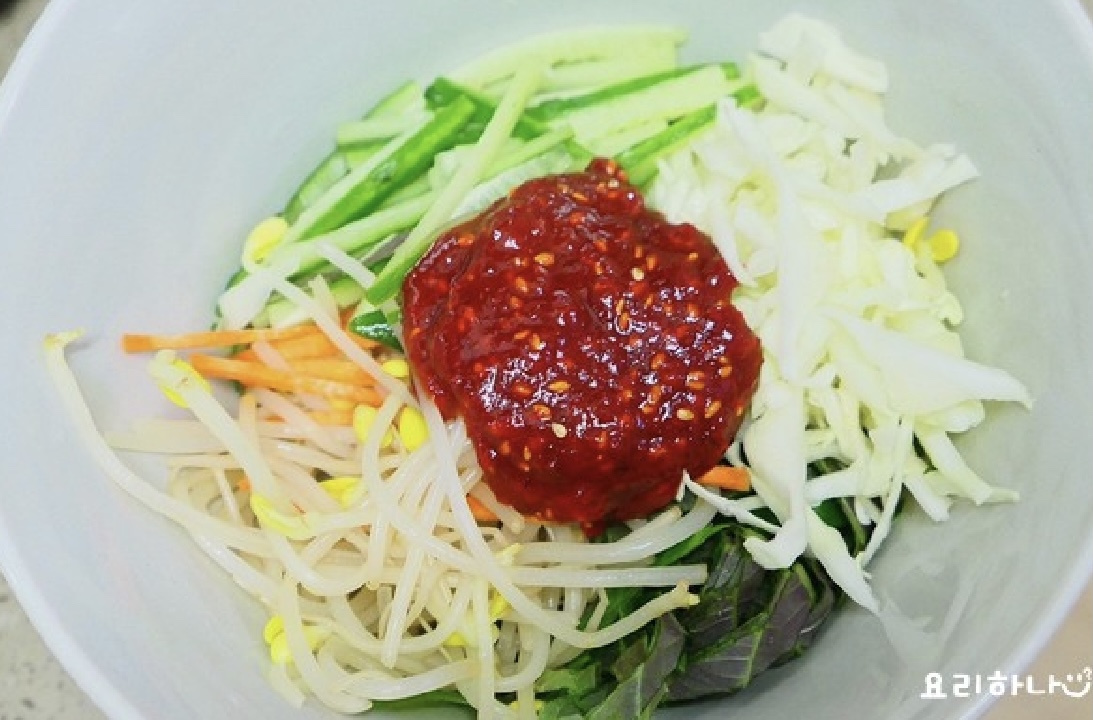Sweet, Sour, and Spicy Baek Jong Won Style Jjolmyeon
The Perfect Recipe for a Lack of Appetite! Super Simple Baek Jong Won Jjolmyeon (feat. Crispy Veggies and Chewy Noodles)

Jjolmyeon, packed with fresh vegetables and boasting a sweet, sour, and spicy flavor, is perfect as a side dish for fried foods or as a standalone snack! Enjoy it as a late-night treat with fried dumplings, or pair it with kimbap. I made this simple recipe to accompany my donkatsu, but it’s satisfying enough to be a meal on its own. Let me share this delicious and easy Baek Jong Won Jjolmyeon recipe.
Ingredients- 1 serving of Jjolmyeon noodles
- Generous amount of fresh perilla leaves
- Generous amount of crisp cabbage
- Generous amount of colorful carrots
- Generous amount of crisp cucumber
- Generous amount of crisp bean sprouts
- 1 Tbsp Gochujang (Korean chili paste)
- 1.5 Tbsp Gochugaru (Korean chili flakes)
- 2 Tbsp Soy Sauce
- 0.5 Tbsp Minced Garlic
- 1.3 Tbsp Korean Plum Extract (Maesil)
- 1 Tbsp Sugar
- 2.8 Tbsp Vinegar
- 0.3 Tbsp Sesame Oil
- 0.5 Tbsp Toasted Sesame Seeds
Cooking Instructions
Step 1
First, prepare the fresh vegetables to accompany your Jjolmyeon. Wash the perilla leaves, cabbage, carrots, and cucumber thoroughly, then thinly julienne them. If you like cucumber, feel free to add more. The bean sprouts (not pictured) should be blanched in boiling water for about 4-5 minutes until they are still crisp. Rinsing them in cold water and draining will enhance their crunchiness, making your Baek Jong Won Jjolmyeon even more delicious.

Step 2
Now, let’s make the special sauce for Baek Jong Won Jjolmyeon. In a bowl, combine 1.5 tablespoons of gochugaru (chili flakes), 1 tablespoon of gochujang (chili paste), 2.5 tablespoons of vinegar, 2 tablespoons of soy sauce, 1 tablespoon of sugar, 0.5 tablespoon of minced garlic, 1 tablespoon of plum extract, and 0.3 tablespoon of sesame oil. The aroma of sweet, sour, and spicy will start to waft out, making your mouth water.

Step 3
Mix all the sauce ingredients together thoroughly with a spoon. Taste and adjust the seasoning to your preference. I personally prefer a bit more sweetness, so I added an additional 0.3 tablespoon of plum extract and 0.3 tablespoon of vinegar to perfectly suit my taste. You can adjust the quantities according to your preference. Once the seasoning is to your liking, stir in 0.5 tablespoon of toasted sesame seeds for a nutty aroma.

Step 4
With the sauce ready, it’s time to cook the Jjolmyeon noodles. If the noodles are clumped together, briefly soak them in cold water and gently rub them with your hands to separate them. Cooking them after separation ensures they cook evenly without sticking. Boil the Jjolmyeon noodles in boiling water for about 7 minutes. Once cooked to a chewy texture, quickly drain them and rinse thoroughly under cold running water. Drain them well in a colander. Place the chewy and springy Jjolmyeon noodles into your serving bowl.

Step 5
Now, artfully arrange the prepared fresh vegetables on top of the Jjolmyeon in the bowl. Place the perilla leaves and cucumber, which are similar shades of green, in different areas to create visual contrast. Arrange the cabbage and bean sprouts on the opposite side. Finally, add the colorful carrots neatly on top.

Step 6
Next, spoon the delicious Jjolmyeon sauce you made earlier over the noodles and vegetables. This simple assembly results in a visually appealing dish, much like a flavorful bibimbap.

Step 7
Baek Jong Won’s Jjolmyeon, made so easily, right? When you crave something sweet, sour, and spicy, especially when your appetite is lacking, this dish is the perfect solution.

Step 8
Finally, mix everything together – the noodles, vegetables, and sauce – until well combined. I briefly considered adding a few ice cubes for extra coolness, but the noodles, rinsed in cold water, and the fresh vegetables provided enough refreshing crispness to make it delicious as is. I originally made this Baek Jong Won Jjolmyeon to pair with donkatsu, and it was indeed a fantastic combination! It’s also great served with rice or enjoyed on its own. If you enjoy spicy food, I plan to add a bit more gochujang next time for an even spicier kick. And with that, another delicious dish is complete!




